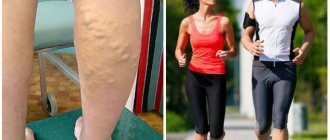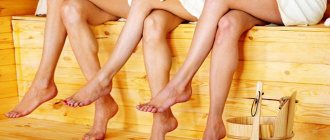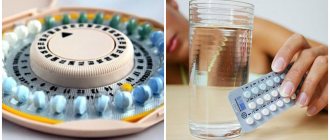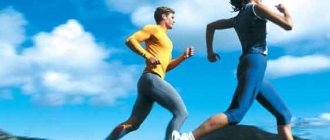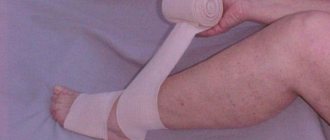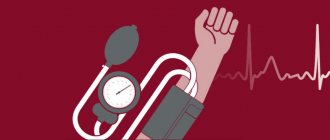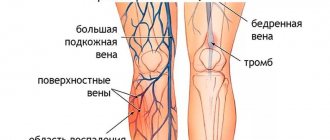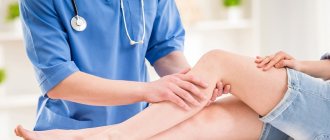What is varicose veins?
Varicose veins are swelling of veins and elongation of venous valves, which most often occurs due to improper muscle function. Most often this becomes the result of an incorrect lifestyle, such as:
- the need to sit for 6-8 hours a day, mainly in one position, be it sitting at a desk in an office or driving a vehicle;
- constant lifting and carrying heavy objects;
- In women, the factor that often leads to the appearance of varicose veins is an excessive love of high heels.
Important! All these actions lead to overstrain of the leg muscles and, as a result, pressure on the blood vessels. In such a situation, blood stagnation occurs in the body, since the muscles cannot constantly compress and unclench the vessels, which leads to varicose veins.
Reasons to exercise
A huge number of people consider sports and physical activity to be “not for everyone.” Yes, during my school years I had to go to physical education, but then even exercise disappeared from my usual life.
But in vain. You should not look for illnesses in yourself, or cling to reasons that do not allow you to realize the body’s healthy need for reasonable physical activity.
Physical education is the prevention of a huge number of diseases, it also extends youth and an active period of life.
Gymnastics for varicose veins
Phlebologists have developed special exercises that significantly improve a person’s condition with varicose veins, and in some cases even help get rid of this disease.
The “birch tree”, “scissors”, and “bicycle” exercises are very effective It is also recommended to walk on your toes and swing your legs. The main thing is that all exercises are moderate and regular.
Varicose veins are an extremely unpleasant disease that can have dangerous health consequences. Therefore, when it appears, it is recommended to consult a doctor as soon as possible - only a specialist will be able to select adequate physical activity and prescribe effective treatment.
Prohibited species
What sports can you do if you have varicose veins? Those sports that will put a moderate load on your legs without overworking them will be useful. The most useful are 4 types of sports activities.
- Race walking or jogging (see how to jog with varicose veins). Daily exercise stimulates blood circulation in the extremities and prevents the formation of venous stagnation.
- Swimming in the pool and water aerobics. Exercising in water reduces stress on joints. Water gently massages the muscles, eliminating their spasm. This helps restore blood flow and lymphatic drainage.
- A ride on the bicycle. The best prevention of congestion.
- Golf. This sport combines static and dynamic load on the limbs.
Alternative options are exercises on sports equipment, fitness, and dancing. For these sports exercises, the doctor must determine the maximum allowable amount of load, taking into account the stage of the disease.
Is it possible to exercise with varicose veins in the gym? Only certain types of exercise equipment are allowed that do not involve a lot of stress on the legs. For dance exercises, it is best to choose belly dance or tango.
If we talk about fitness for varicose veins, the optimal activities are:
- Yoga;
- Pilates;
- Shaping;
- Stretching.
At the first stage of the disease, all of the listed sports are allowed. For moderately severe varicose veins, therapeutic exercises and yoga are indicated. People with the third stage are allowed only moderate walking.
During physical therapy, the following exercises are performed:
- “Swallow” - standing on one leg with the body extended forward, raise the second leg back;
- Shoulder stand, or “birch tree” exercise;
- Rhythmic flexion and extension of the legs while lying on your back;
- Exercises "bicycle" and "scissors".
Important! The therapeutic effect is observed only if training takes place regularly and at the recommended pace.
Some sports are contraindicated for varicose veins of the legs, as they can cause bleeding or blood clot rupture. These include activities that involve significant stress on the legs. Contraindications for varicose veins:
- Fast and long run;
- Long and high jumps;
- Aerobics with a stepper;
- Squats;
- Strength exercises with a barbell;
- Basketball, volleyball, football;
- Sports wrestling;
- Horseback Riding;
- Extreme sports.
With varicose veins, bumps, jumps, and the impact of heavy weights on the legs are very dangerous. When practicing yoga, static poses that require long periods of immobility are undesirable.
People who are used to leading an active lifestyle are wondering: what kind of sports can you do with varicose veins?
Patients who have information about whether it is possible to play sports with varicose veins of the legs should know what types of physical activity are considered possible contraindications. Moderate physical activity is encouraged, while it will be recommended to refrain from performing intense physical activity.
Static exercises can create excess pressure on the veins of the lower extremities and can only aggravate the disease.
Patients are contraindicated from lifting heavy objects; they will also have to abstain from professional sports that involve intense power loads.
After surgery, physical activity includes walking in the fresh air and performing therapeutic exercises as recommended by the attending physician.
Having received information about whether it is possible to play sports with varicose veins in the legs, you should remember that before giving preference to one or another type of physical activity, you must first consult with a doctor.
Exercising with varicose veins is not limited to exercise alone. It must be taken into account that the rate of development of the disease is different for everyone, and what is acceptable at one stage is already dangerous at another.
The most optimal sports for varicose veins of 1-3 degrees will be:
- Swimming;
- Yoga (not intensive);
- Walking (no more than half an hour a day);
- Gymnastics and stretching.
Moreover, if you decide to do gymnastics, then you should avoid moments when you need to stay in one position for quite a long time. Especially if you feel your leg becoming numb and numb during training, you need to change something.
Why do doctors advise combining varicose veins and swimming?
Indeed, doctors often tell their patients how valuable swimming is for varicose veins. This disease means a ban on strength and jumping exercises, but the same strength aerobics is perfectly replaced by water aerobics. It is this that puts a small load on the legs, while the body, muscles, and joints work. Even jumping will not be dangerous in the water, as it absorbs shock.
Also, swimming and varicose veins are ideally compatible, because in a person who is in a horizontal position, there is an outflow of blood from the lower extremities, and this is the main goal of sports for such a disease. But swimming not only helps to mitigate the course of the disease, it is also useful for other problems, and as a preventive measure for a huge number of pathologies.
Why is aqua therapy so useful:
- Due to the fact that the body remains in a horizontal position for a long time, the intensity of stagnant processes in the legs decreases.
- Swimming and other water activities improve blood flow to the heart and are an effective adjuvant therapy and prevention of many cardiovascular diseases.
- Hydromassage occurs not only for the legs, but also for the whole body. Of course, against this background, your well-being improves. Swimming is one of the best ways to relieve muscle fatigue.
- Shock loads in water are excluded. In this sense, exercises in the pool are superior even to physical therapy.
The optimal training regimen is twice a week, more often is not necessary. If you do everything correctly during these two sessions, then this load will be enough. Don't take more than four days between workouts. Be sure to monitor your health; if your health worsens, you need to stop and don’t exercise forcefully.
Be that as it may, no matter how excited you are about buying a pool membership, you should first consult a doctor. You yourself will have peace of mind knowing that the doctor approved such activity. In addition, the doctor will give some more useful, individual recommendations and coordinate your further actions.
Yoga can be considered an excellent prevention of varicose veins. But even if the disease has already fully developed, you should not give up yoga. These exercises will effectively help relieve leg fatigue and tension. The big advantage of yoga is that other sports with varicose veins may require special conditions - you need to go somewhere, buy a subscription, work out with a trainer, etc. – Yoga is quite suitable for home exercises.
Objectives of yoga for varicose veins:
- Muscle work - thanks to it, blood is literally pushed out of the veins and begins to circulate normally;
- Development of flexibility, and this also helps to combat stagnant processes.
Many women have naturally stiff muscles and lack flexibility. But at the same time they are physically strong. So yoga will focus specifically on muscle stretching. Muscle extension and contraction are the main components of human muscular activity.
But the attitude towards yoga should not be amateurish, since some yoga exercises cause vascular compression, others - their stretching. It is important not to cause harm and not achieve the opposite effect.
One of the useful yoga exercises for varicose veins:
- This exercise is called Paschimottanasana. To put it simply, bend towards your feet while sitting.
- Hold your knees with your hands, but your back should not be bent.
- Helping yourself with your hands, gradually stretch your back.
- Relax your back, slowly lowering it lower and lower towards your feet.
- The exercise is performed for half a minute or a minute.
- Pull your lower back, raise your head. Bend your chest and back, return your back to a vertical position, vertebra by vertebra, carefully.
If, in addition to varicose veins, you have arthritis or radiculitis, as well as diseases associated with displaced spinal discs, you should avoid such exercises.
They are also contraindicated for people with bronchial asthma, as well as for expectant mothers.
What kind of walking is useful for illness?
You should not run for more than 30 minutes or jump for more than five minutes. Sessions on an exercise bike should not exceed half an hour. Active strength training with heavy loads does not improve the health of your legs.
Squats with a barbell and any types of leg presses are dangerous for patients with varicose veins. You should not do all kinds of exercises with increased pressure on your legs at one time - this is dangerous.
You are not allowed:
- do exercises that involve standing in one position for a long time;
- use rubber sneakers and shoes that are not suitable for the chosen sport;
- wearing clothes that are too tight (especially in the pelvic area);
- walk and run in places where there is soil under your feet and not a surface (rubber, asphalt).
Absorb the impact of your feet on the ground as much as possible with properly fitted shoes and insoles.
Varicose veins are a serious disease that imposes certain restrictions on a person’s lifestyle.
Therefore, many people wonder whether it is possible to play sports with varicose veins.
It is impossible to give a definite answer. After all, if some types of physical activity can significantly reduce the manifestations of varicose veins, others only aggravate the situation.
Sports for varicose veins are not contraindicated, but it is necessary to give preference to those types of sports that do not create strong tension in the leg muscles.
With varicose veins, lack of physical activity is as dangerous as overexertion. There is no developed muscle layer in the venous wall, and venous blood flow is carried out due to the suction force of the diaphragm, as well as the work of the muscular-venous pump.
The muscular-venous pump is a mechanism that ensures the return of blood from the periphery to the heart. Large internal veins are surrounded by muscles.
When they contract, the pressure exerted on the veins pushes blood toward the heart. And the contraction of the pump muscles occurs during movement.
Developed, trained muscles of the foot, lower leg, and thigh help normalize venous outflow. With low physical activity, blood stagnates in the veins, causing the progression of varicose veins.
In addition, physical activity increases the activity of nutrition and blood supply in the tissues, which is very important, since with varicose pathology these functions in the tissues of the legs are reduced. Dosed physical activity prevents the formation of trophic ulcers.
Sports activities, if the loads do not exceed the physiologically acceptable limit, stimulate adaptive-compensatory mechanisms. The body's resistance increases, and compensation processes are activated more quickly in the presence of pathology. Restorative, reparative, immune and anti-inflammatory processes are activated. What is also necessary for varicose veins of the legs.
Exercising increases the number of red blood cells. Thanks to this, the activation of nutrition and gas supply to tissues is ensured. Physical activity stimulates the production of collagen and elastin, so the vein walls regain lost strength and elasticity, permeability and the formation of edema are reduced.
Regular exercise promotes the production of endorphins, the so-called “happiness hormones”. Any disease, including varicose veins, is accompanied by a decrease in psycho-emotional state. Endorphins restore a feeling of joy, relieve depression, and increase confidence in recovery.
Physical activity is recommended for everyone, but it must be comparable to physical abilities. Excessive physical activity can worsen the disease.
Walking is considered the best exercise. Thanks to regular walking, the muscles begin to work and the outflow of blood from the veins accelerates. If you walk for 15–20 minutes every day, you can stop the development of varicose veins.
Walking acts as a warm-up and prepares your legs before running. You need to walk 0.5 km, and then, accelerating, another 0.2 km. It is useful to do race walking for 30–40 minutes a day. It has a beneficial effect on blood vessels. Nordic walking and cross-country walking are also suitable.
Other sports allowed:
- Run. It should not be too intense, otherwise heavy load on the legs can aggravate the problem.
- Skates and rollers. These types of exercises will help strengthen muscles and improve vascular function. You must ride on a flat road.
- Swimming. This sport is perfect for people suffering from varicose veins. During exercise in the pool, all the muscles of the body work, blood circulates better. Water pressure has a healing effect on the legs, alleviating the human condition.
- Bike. Riding gives a useful load on the muscles. You can replace the bicycle with a horizontal exercise bike or an elliptical trainer.
- Skis. If you have varicose veins, walking is allowed and is done daily. You should not choose long distances.
- Outdoor sports have a good therapeutic effect: golf, badminton.
We should also talk about fitness for varicose veins. Of course, it will benefit your legs if the exercise is not too intense. Its effect on the body is expressed as follows:
- metabolic processes are accelerated;
- collateral blood flow is activated;
- tissue cells are better supplied with oxygen;
- leg muscles are strengthened.
Ideally suited:
- yoga;
- dancing (not sports);
- stretching;
- Pilates;
- shaping;
- aerobics (except step).
As for working out in the gym, not all strength exercises are allowed here. The training should take place in a lying or sitting position, while removing the load from the legs. The following equipment is allowed to be used:
- rowing;
- gravitron;
- butterfly;
- jogging track;
- elliptical.
Using an exercise bike for varicose veins of the lower extremities will achieve the following results:
- improve the supply of tissues with necessary substances;
- prevent blockage of veins;
- restore the elasticity of the walls of blood vessels;
- increase blood circulation in the legs.
A daily 30 minutes on an exercise bike is enough to feel the visible effect.
You can pump up your arm muscles using light weight dumbbells. They are used in a sitting or lying position. Suitable equipment includes a fitball and a hoop.
As therapeutic physical training at home, it is allowed to perform birch, “scissors”, “bicycle”, “stretching”, “mill”, “plank”. Therapeutic gymnastics contains a whole range of exercises against varicose veins.
It was developed by phlebologists and does not require much time. While standing on your feet, you need to stand on your toes and stretch 10–15 times.
You need to lift each limb in turn, bending at the knee and swinging to the sides. You can do this kind of gymnastics at any age.
There are contraindications in which the above sports are prohibited. These include:
- postoperative period;
- acute inflammation;
- trophic ulcers;
- phlebothrombosis;
- severe pain and swelling.
Some sports can harm vascular health. These include:
- football;
- motorsports;
- volleyball;
- basketball;
- Horseback Riding;
- powerlifting;
- karate, sambo.
Thus, with varicose veins, you need to limit extreme sports, as well as training related to jumping and intense running. This also includes kayaking. Staying immobile for a long time can lead to stagnation of blood in the veins.
Sports for varicose veins depend on the severity of the disease. So, with the first degree of pathology, almost any training is allowed. During the second stage, jumping and dancing must be excluded. The third degree involves giving up running. In the last stage of the disease, yoga and stretching are suitable.
Some exercises cannot be done with this disease. These include:
- running with obstacles;
- fast run;
- jumping;
- lifting weights;
- rock climbing;
- Weightlifting.
Such exercises can cause surges in blood pressure, which cause stretching of the vascular walls. Performing squats with varicose veins contributes to the formation of blood clots, and in severe forms of the disease can lead to rupture of nodes. Therefore, these exercises are allowed only at an early stage of pathology.
You can only squat while wearing compression stockings. They make movements smoothly, without jerking. Number of repetitions – 10–15 per approach. You cannot hold your breath while doing this.
Naturally, the more disorders and degenerative processes in the body, the greater the chances of getting the serious complications described above when playing sports. The first stage of the pathology is rarely detected, since it has no specific symptoms other than a feeling of heaviness in the legs when walking.
At this stage, you can take on any type of load, except intense running, weightlifting, rock climbing, and parachute jumping. To gain muscle mass, you should first solve the problem with the disease, which at this stage will not be difficult.
The best way to cope with pathology is aerobics and jogging.
The second stage is already manifested by swelling, a feeling of mild cramping, numbness of the toes and unpleasant sensations in general. At this stage, in addition to the above-mentioned sports departments, timed running, aerobics and step (a type of dance) are now excluded.
The ideal solution would be walking and jogging, as well as stretching, yoga, and static loads such as callanetics for stretching. You can also use any exercise equipment except lifting barbells and similar equipment - this is the main contraindication to strength training.
The average degree, at which people most often turn to a phlebologist, has the following manifestations: pain in the affected area, cramps, severe swelling, accelerated fatigue, cyanosis, toes become numb and slightly blue, trophic ulcers may form.
This stage is almost always accompanied by the complications listed earlier. In addition to the above mentioned sports and leisure activities, it is prohibited to use martial arts.
Sports activities are carried out only in compression underwear, which will support the normal functioning of blood vessels during increased load. Recommended activities other than stretching include walking for 20-30 minutes, yoga, swimming, water aerobics and qigong.
It is permissible to engage in bodybuilding with varicose veins if the load on the lower limbs is eliminated. That is, any leg exercises are eliminated from the mandatory program and replaced with more gentle analogues for treatment. It is also recommended to treat varicose veins before gaining muscle mass.
Running is also allowed for varicose veins, but only for a short time - about half an hour maximum - and not intense. That is, sprint, timed, and marathon running are excluded. But jogging in the early stages is acceptable. You can use interval running, in which the running speed changes, but it is better not to reach the limit values.
Cardio exercises - aerobics and its types, Zumba and other intense activities are effective if you do not do them to the point of exhaustion. As in the case of running, a maximum of half an hour and with breaks. By the way, if the patient is overweight, it is recommended to first lose it with a diet in order to reduce the load on the legs.
Useful and effective exercises
Many types of exercises are strictly contraindicated for varicose veins, but you can always choose an effective set of permitted physical activities. These include bodyflex. It combines a whole complex of stretching, isometric, isotonic exercises combined with a specific breathing technique.
If varicose veins are severe, leg exercises can be avoided. As a result of training, all muscles are tightened, and the body is saturated with oxygen. Bodyflex contains exercises for losing weight for varicose veins at home. It is enough to devote 15 minutes to training twice a day. An increase in the therapeutic effect of bodyflex is facilitated by the addition of exercises from therapeutic gymnastics for varicose veins of the legs.
standing
While standing, you can perform the following sports exercises when varicose veins appear:
- Stand up straight, place your feet parallel. Slowly rise on your toes and lower to the starting position. The number of repetitions is 20 times.
- Walk on the floor first on your toes, then on your heels for 5 minutes.
- Walk at a ski step, trying not to lift your feet off the floor, for 5 minutes.
- Place your right foot on top of your left, then raise the toe of your left foot as high as possible. Repeat 10 times and change legs.
These leg exercises can be done at home or at work to prevent vein strain.
Sitting
In a sitting position, you can perform the following set of exercises for varicose veins of the legs:
- Sit on a chair, raise your right leg above the floor, rotate your foot clockwise, then counterclockwise, performing 20 rotations. Do a similar exercise for the left leg.
- Bend and tense your toes until tension appears. After that, relax. Repeat 10 times.
- Place your feet on the floor, perform rotational movements with your feet, then lift your heels and forcefully lower them to the surface.
If you plan to exercise on a cardio machine, it is recommended to abandon the treadmill in favor of rowing: in this case, your legs will be less stressed than on the treadmill.
On the back
Fitness exercises in a lying position:
- Lie on your back, bend your knees, pedal the “bicycle.” It is important to fully straighten your legs to get maximum benefit from the exercise.
- Lie on your back and pull your legs towards your chest, then straighten them up and slowly lower them to the floor. This exercise helps to pump up your abs just as effectively as regular crunches.
- Lie horizontally, arms extended along the body. Raise your legs up and cross them at a medium rhythm. Avoid shortness of breath.
For the buttocks
Special exercises for the buttocks for varicose veins minimize the load on the veins of the lower extremities.
- Lie on the floor, legs slightly apart, bend at the knees. Raise your hips as high as possible, fixing at the highest point for 2 seconds. Repeat 25–30 times. To increase the load on the gluteal muscles, you can place a small weight on your hips.
- Take a knee-elbow position, raise one leg and bend at the knee. Raise your leg up, trying to reach your heel towards the ceiling. Repeat 25 times, then rest and repeat on the other leg.
- Exercises for the buttocks with varicose veins at home include the usual squats and lunges, but they must be performed carefully, increasing the load as the muscles warm up.
It won't hurt to pump up your buttocks. By performing this simple set of exercises, you can significantly improve the shape of your back and inner thighs.
Contraindications
It is allowed to use only those sports for varicose veins that do not involve powerful loads. If the body is regularly overloaded, it will not be possible to achieve recovery. It's not just strength training that you should give up. Static loads can also have a negative effect.
Compression garments help minimize the stress on your legs. It is best to coordinate your training schedule and intensity with your doctor. He will be able to select the load depending on the specific case.
For varicose veins, it is necessary to undergo a comprehensive examination once a year. In this case, it will be possible to prevent the development of serious complications.
A trainer without a medical education will not be able to recognize the pathology and select the correct intensity of the load. In this matter, you should only trust a doctor.
It is allowed to combine varicose veins and sports. Contraindications in the field of physical activity for this disease:
- Under static loads, the veins in the legs become very tense. That is why you should avoid exercises with prolonged tension of all limbs. They can also trigger the development of varicose veins.
- There are also contraindications for jumping and intense training.
- You can start exercising only after a thorough warm-up, aimed at warming up all muscle groups. Thanks to this, blood begins to circulate in the correct mode.
- If you have varicose veins, you should not play football, volleyball, basketball or wrestle. These sports lead to excessive muscle tension in the limbs.
The answer to the question of whether it is possible to play sports with varicose veins of the legs directly depends on the nature and intensity of the manifestation of the disease. During training, there is no need to rush and raise the limbs to a level above the pelvis.
Only calm walking in everyday life can prevent the situation from getting worse.
Massage also has a positive effect. A set of necessary manipulations improves blood circulation and normalizes metabolic processes in tissues.
Is it possible to play sports with varicose veins? You already understand this. But there are certain types of physical activity that are highly not recommended for this disease.
Statistical exercises can contribute to excess pressure on the veins of the legs, and as a result, varicose veins will only worsen. It is strictly forbidden to lift weights, so intense power loads will have to be abandoned.
Skydiving, mountaineering and horse riding are completely contraindicated.
Is it possible to play sports with varicose veins? Of course you can. But if you have varicose veins in your legs, you should exercise very carefully. After all, the wrong type of sports activity or exercise can only harm your overall health.
Before you go to a sports club or get on a treadmill, it is best to consult a doctor who will determine the degree of varicose veins and give recommendations regarding the type of load.
In any case, sport, even if you are not sick, can cause harm. Especially when it comes to high performance sports. Of course, if you go to the gym with varicose veins and decide to lift weights, you will only worsen the disease. Why? When a person lifts a barbell, he loads not only his legs, but also their blood vessels. Eventually they burst and you see a new spider vein or hematoma on your leg.
You should not engage in cross-country sports; skiing and skating are also not the best option. Such dynamic activities will be harmful for varicose veins. Therefore, focus on calmer physical activity that does not require such a high load on the legs.
Complications of varicose veins (thrombophlebitis, thromboembolism, open trophic ulcers) should be a signal that it is advisable to leave sports until you return to an earlier stage of the disease. If you have blood clots or are prone to them, physical activity can only make the situation worse. Therefore, only morning exercises and massage are available.
As you can see, varicose veins and sports are completely compatible concepts, albeit with exceptions. And if you choose the right types of exercises and approach them with caution, you can not only keep yourself in good shape throughout the disease, but also contribute to the treatment of varicose veins.
You cannot engage in sports that involve increased physical activity with varicose veins. Contraindications include skiing, mountaineering, and long-distance running.
You cannot exercise with weights (dumbbells, barbells) doing lunges and squats. You cannot choose a sport that involves jumping (step aerobics, long jump, pole vaulting, parachuting, etc.)
etc.), as well as Irish dancing. Prolonged static load is also contraindicated, for example, when practicing callanetics, some asanas in yoga.
All extreme sports are contraindicated, since they are not only accompanied by high loads, but also carry the risk of injury and the risk of blood clot rupture.
Contraindications must be stated by the doctor during consultation. He will also recommend those sports that will not cause harm to varicose veins.
Varicose veins in athletes excludes exercises that lead to increased pressure on the vessels and additional muscle tension. Contraindications are:
- weighted squats;
- lifting a weight or barbell;
- intense or long running;
- jumping and rope exercises;
- step aerobics.
Once varicose veins go away in athletes, they can gradually increase the load. But you will still have to forget about sports where you need to lift a lot of weight or injure your legs forever.
Disease prevention
If you do not yet have the disease, but you suspect that it threatens you, urgently find time to prevent it. Moreover, it does not involve anything overly complex or costly.
To do this, carefully study the following nine recommendations.
For prevention, various exercises are done that help normalize blood circulation and prevent blood vessels from losing their elasticity. You can do the following light exercises:
- Flexion and extension of the leg at the ankle and knee;
- Rotate the leg in these sections;
- Knead your calves with your hands;
- Pull your toes back - stretch them as if you were standing on tiptoes, and then pull them up towards you;
- Jump on tiptoes.
These exercises are effective at any stage of varicose veins. A 5-10 minute performance is enough. This is considered the best preventive method to prevent the development and progression of varicose veins, especially in those people who are forced to lead a sedentary lifestyle.
Prognosis for recovery
Varicose veins progress if physical activity is excessive and decrease when exercise is balanced. The main rules that must be followed to benefit from sports:
- do not lift heavy weights;
- do not engage in fast or long running;
- do not use exercise bikes other than elliptical models;
- choose mainly exercises in which the legs are positioned level with the body or higher;
- have a good rest after classes;
- If you feel worse, consult a doctor immediately.
If the patient follows these recommendations, his blood vessels are strengthened. After 1-2 years, when varicose veins become milder, it will be possible to expand the range of exercises. For preventive purposes, it is recommended to do a leg warm-up during the working day:
- bend and straighten the leg at the knee and ankle joints;
- rotate the leg at the knees and shins;
- knead your calves with your hands;
- pull your toes back, jump on tiptoes.
You can do these simple exercises for 5-10 minutes at any stage of varicose veins.
Precautionary measures
Running is good for the cardiovascular system. But don’t forget to follow important rules:
- the duration of the workout should not exceed 30 minutes;
- the running pace is calm;
- choose a dirt surface for training rather than asphalt;
- shoes must be special;
- It is recommended to perform the exercise in the first half of the day.
In addition to fitness, a person must adhere to a healthy lifestyle and proper nutrition. Perform exercises only after consultation with your doctor.
Before each session, you need to warm up and monitor your well-being.
